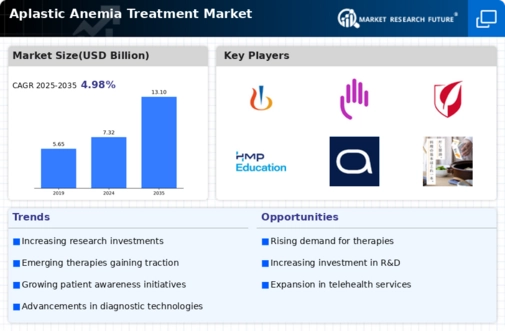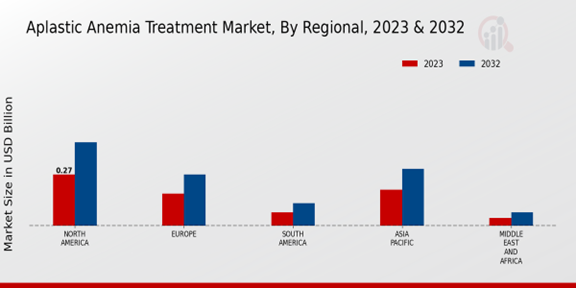Market Growth Projections
The Global Aplastic Anemia Treatment Market Industry is projected to experience substantial growth over the next decade, with estimates indicating a market value of 7.32 USD Billion in 2024 and a significant increase to 13.1 USD Billion by 2035. This growth trajectory suggests a compound annual growth rate (CAGR) of 5.45% from 2025 to 2035. Such projections are indicative of the increasing demand for effective treatment options and the ongoing advancements in medical research and technology. The market's expansion reflects a broader trend towards improved healthcare solutions for rare diseases, positioning it as a critical area of focus for stakeholders.
Rising Awareness and Diagnosis
Increased awareness about aplastic anemia and its symptoms is contributing to earlier diagnosis and treatment, thereby positively impacting the Global Aplastic Anemia Treatment Market Industry. Healthcare providers are becoming more adept at recognizing the signs of this condition, leading to timely interventions. Educational campaigns and initiatives by health organizations play a crucial role in disseminating information about aplastic anemia. This heightened awareness not only facilitates better patient outcomes but also drives demand for treatment options, as more individuals seek medical attention. Consequently, the market is poised for growth as more patients are diagnosed and treated effectively.
Government Initiatives and Funding
Government initiatives aimed at improving healthcare infrastructure and funding for rare diseases are significantly influencing the Global Aplastic Anemia Treatment Market Industry. Various countries are implementing policies to enhance research and development in the field of hematology, which includes aplastic anemia. Increased funding for clinical trials and research projects is likely to lead to the discovery of new treatment options and improved patient care. These initiatives may also encourage collaboration between public and private sectors, fostering innovation. As a result, the market is expected to experience sustained growth, driven by these supportive governmental efforts.
Growing Investment in Biotechnology
The Global Aplastic Anemia Treatment Market Industry is experiencing a surge in investment in biotechnology, particularly in the development of targeted therapies and biologics. This trend is driven by the potential for these therapies to provide more effective and personalized treatment options for patients with aplastic anemia. Biotech companies are increasingly focusing on research that aims to understand the underlying mechanisms of the disease, which could lead to breakthroughs in treatment. As the market evolves, the compound annual growth rate (CAGR) of 5.45% from 2025 to 2035 indicates a robust growth trajectory, fueled by these investments.
Advancements in Treatment Modalities
The Global Aplastic Anemia Treatment Market Industry benefits from ongoing advancements in treatment modalities, including immunosuppressive therapies and hematopoietic stem cell transplantation. These innovations enhance patient outcomes and expand the range of available treatment options. For instance, the introduction of novel immunosuppressive agents has shown promising results in improving hematologic recovery rates among patients. As these therapies continue to evolve, they are likely to attract more investment and research, further driving market growth. The anticipated market value of 13.1 USD Billion by 2035 underscores the potential of these advancements to transform the treatment landscape.
Increasing Prevalence of Aplastic Anemia
The Global Aplastic Anemia Treatment Market Industry is witnessing a notable rise in the prevalence of aplastic anemia, which is a rare but serious condition characterized by the failure of bone marrow to produce sufficient blood cells. This increase is attributed to various factors, including genetic predispositions and environmental influences. As the number of diagnosed cases rises, the demand for effective treatment options is expected to grow significantly. In 2024, the market is projected to reach 7.32 USD Billion, reflecting the urgent need for innovative therapies and management strategies to address this life-threatening condition.


















